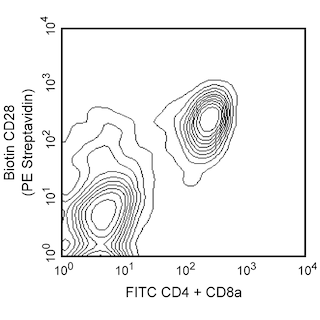Old Browser
This page has been recently translated and is available in French now.
Looks like you're visiting us from {countryName}.
Would you like to stay on the current country site or be switched to your country?


.png)

Expression of IL-10 by stimulated CD4+ Balb/c spleen cells. Purified splenic CD4+ cells from 6 month old BALB/c mice were stimulated with plate-bound anti-CD3 (145-2C11, Cat. No. 553057 at 25 µg/ml) and soluble anti-mouse CD28 (clone 37.51, Cat. No. 553296 at 2 µg/ml) for 2 days in culture together with recombinant mouseIL-2 (10 ng/ml, Cat. No. 550069) and recombinant mouse IL-4 (50 ng/ml, Cat. No. 550067), followed by a 3 day incubation with only IL-2 and IL-4. This was followed by a 5 hour stimulation with plate-bound anti-CD3 (25 µg/ml) and anti-mouse CD28 (2 µg/ml) in the presence of GolgiStop™ (Cat. No. 554724). The cells were then stained with 0.06 µg of FITC-conjugated rat anti-mouse CD4 (FITC-RM4-5, Cat. No. 553046) and 0.25 µg of APC-conjugated rat anti-mouse IL-10 antibody (APC-JES5-16E3, Cat. No. 554468) by using Pharmingen's staining protocol (left panel). To demonstrate specificity of staining, the binding of APC-JES5-16E3 was blocked by the preincubation of the conjugated antibody with a molar excess of recombinant mouse IL-10 (0.12 µg, Cat. No. 550070; middle panel), and by preincubation of the fixed/permeabilized cells with an excess of the unlabelled JES516E3 mAb (3.6 µg, Cat. No. 554464; right panel). The quadrant markers for the bivariate dot plots were set based on the autofluorescence control, and verified with the recombinant cytokine blocking (middle panel) and unlabeled antibody blocking (right panel) specificity controls. A suitable rat IgG2b isotype control for assessing levels of background staining on fixed/permeabilized mouse cells is APC-R35-38 (Cat. No. 556924); use at comparable concentrations to antibody of interest (e.g., ≤ 0.5 µg / 1 million cells). This APC-conjugated reagent can be used in any flow cytometer equipped with a a dye, HeNE or red diode laser. These include the dual laser FACStarPLUS™, FACS Vantage™ or FACSCalibur™.
.png)

BD Pharmingen™ APC Rat Anti-Mouse IL-10
.png)
Regulatory Status Legend
Any use of products other than the permitted use without the express written authorization of Becton, Dickinson and Company is strictly prohibited.
Preparation And Storage
Recommended Assay Procedures
Immunofluorescent Staining for Flow Cytometric Analysis: The APC-conjugated JES5-16E3 antibody can be used for multicolor flow cytometric analyses to identify and enumerate IL-10 producing cells within mixed cell populations (see image). For optimal immunofluorescent staining with flow cytometric analysis, this anti-cytokine antibody should be titrated (≤ 0.5 µg mAb/million cells). For specific methodology, please visit our web site, www.bdbiosciences.com, and go to the protocols section or Chapter 4: Immunofluorescent Staining of Intracellular Molecules for Flow Cytometric Analysis in the Techniques for Immune Function Analysis Application Handbook 1st Edition. 2003.
ELISA: The purified JES5-16E3 is useful as a capture antibody for a sandwich ELISA for measuring mouse IL-10 protein levels.
Product Notices
- Since applications vary, each investigator should titrate the reagent to obtain optimal results.
- Please refer to www.bdbiosciences.com/us/s/resources for technical protocols.
- For fluorochrome spectra and suitable instrument settings, please refer to our Multicolor Flow Cytometry web page at www.bdbiosciences.com/colors.
- This APC-conjugated reagent can be used in any flow cytometer equipped with a dye, HeNe, or red diode laser.
- Caution: Sodium azide yields highly toxic hydrazoic acid under acidic conditions. Dilute azide compounds in running water before discarding to avoid accumulation of potentially explosive deposits in plumbing.
Companion Products

.png?imwidth=320)




The JES5-16E3 monoclonal antibody specifically binds to the mouse cytokine, Interleukin-10 (IL-10). IL-10 is also known as Cytokine Synthesis Inhibitory Factor (CSIF). It is produced by various activated cell types including CD4+ T cells, CD8+ T cells, T regulatory cells, NK T cells, B1 B cells, NK cells, macrophages, dendritic cells, mast cells, granulocytes and keratinocytes. IL-10 plays a pivotal role in regulating immune responses and protecting the host from damage caused by inflammatory and autoimmune responses. IL-10 has numerous biological activities including the inhibition of cytokine synthesis by activated T cells, NK cells, monocytes, and macrophages. In the presence of accessory cells, IL-10 inhibits mitogen- or anti-CD3 induced proliferation of T lymphocytes. IL-10 has also been shown to costimulate the development of thymocytes, B cell differentiation and the generation of cytotoxic T cells. The immunogen used to generate the JES5-16E3 hybridoma was recombinant mouse IL-10. JES5-16E3 is a neutralizing antibody.

Development References (3)
-
Andersson U, Andersson J. Immunolabeling of cytokine-producing cells in tissues and in suspension. In: Fradelizie D, Emelie D, ed. Cytokine Producing Cells. Paris: Inserm; 1994:32-49.
-
Litton MJ, Sander B, Murphy E, O'Garra A, Abrams JS. Early expression of cytokines in lymph nodes after treatment in vivo with Staphylococcus enterotoxin B. J Immunol Methods. 1994; 175(1):47-58. (Clone-specific: Neutralization). View Reference
-
Sander B, Hoiden I, Andersson U, Moller E, Abrams JS. Similar frequencies and kinetics of cytokine producing cells in murine peripheral blood and spleen. Cytokine detection by immunoassay and intracellular immunostaining. J Immunol Methods. 1993; 166(2):201-214. (Clone-specific: Immunocytochemistry (cytospins), Neutralization). View Reference
Please refer to Support Documents for Quality Certificates
Global - Refer to manufacturer's instructions for use and related User Manuals and Technical data sheets before using this products as described
Comparisons, where applicable, are made against older BD Technology, manual methods or are general performance claims. Comparisons are not made against non-BD technologies, unless otherwise noted.
For Research Use Only. Not for use in diagnostic or therapeutic procedures.
Report a Site Issue
This form is intended to help us improve our website experience. For other support, please visit our Contact Us page.